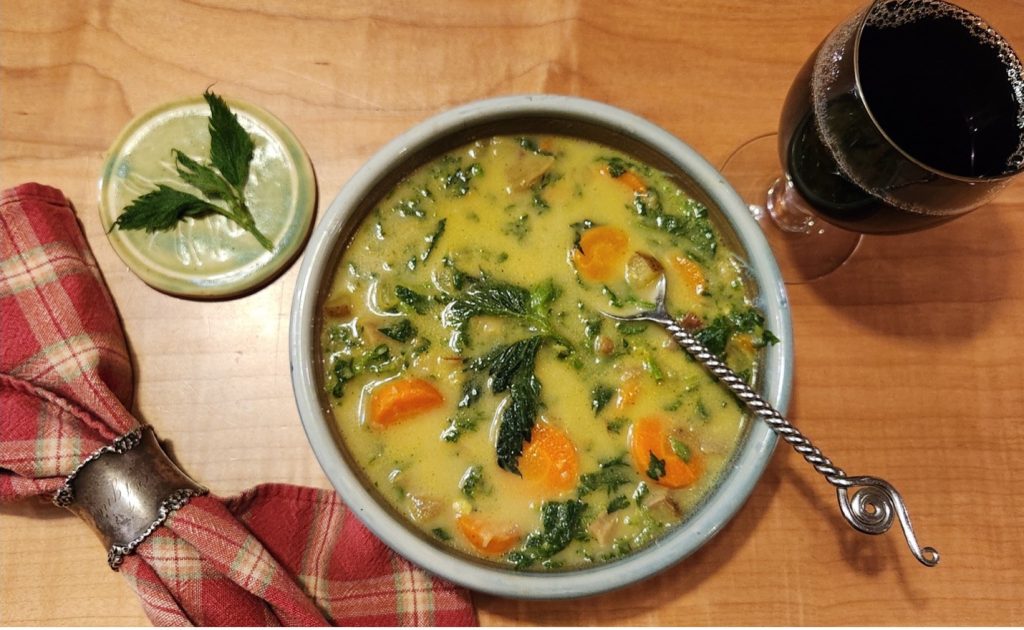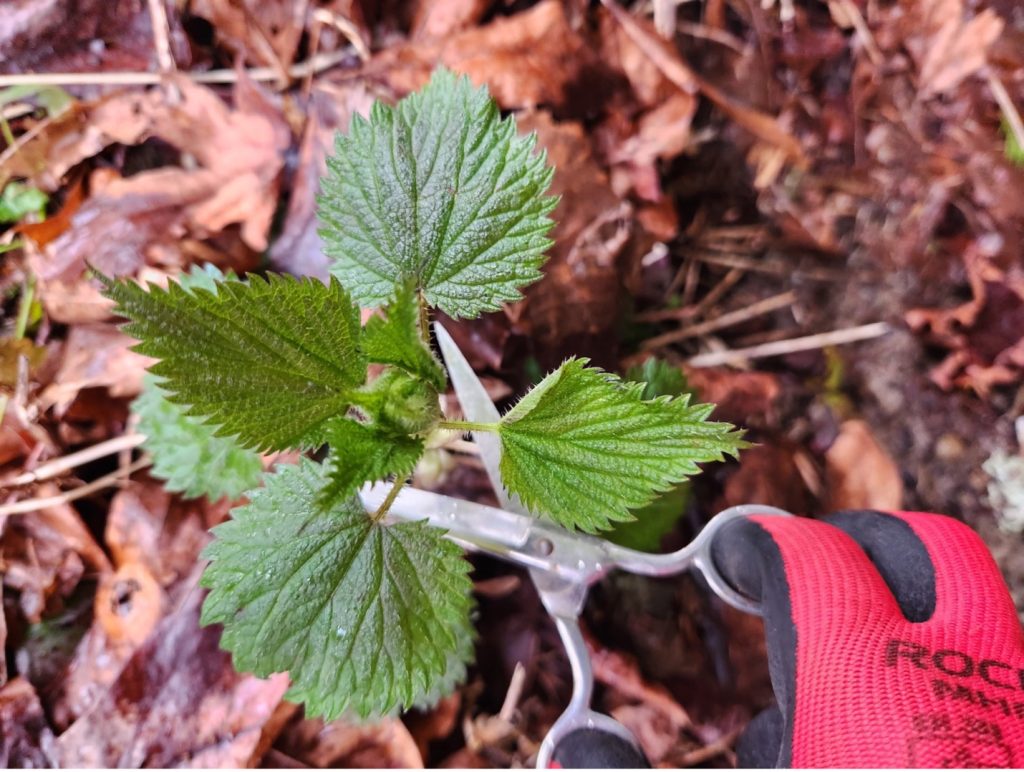TASTE THE RITES OF SPRING!
SEA WOLF CREW RECIPES
FEATURED IN “PACIFIC HARVEST: A Northwest Coast Foraging Guide”
Spring has sprung here in the Pacific Northwest! The signs are everywhere from forest to sea! We made Spring Nettle Curry Soup and ate it for lunch in big globby spoonful’s! This afternoon, we watched great blue herons at a local Rookery repairing their stick nests in a grove of cottonwood trees. Pine siskins whistled in a blooming choke cherry tree. The flock fluttered through the tangled branches clipping blooms with their beaks. We stood below, still as a herons, staring up while white petals floated down like snow.
At sunset we climbed down to a low tide beach for a look around. The newly exposed rocks glistened with tiny blades of Nori seaweed. Come May, this delicious superfood, high in protein and umami-flavor, will be ready for harvesting. In the meantime, Sugar Kelp is at its prime in “seaweed farms” from Washington to Alaska. “Ocean farmers” are hauling in undersea cables “seeded” this past winter with tiny kelp spores. Come March and April, the cables are draped with long golden kelp blades thick as hula skirts. Sugar Kelp is naturally sweet due to “mannitol”—which is used to sweeten diabetic-friendly foods while maintaining a low glycemic index. It has a salt-forward, mild sweetness when dried and flaked.
Here are three yummy recipes from the SEA WOLF CREW to celebrate SPRING!
They are from Jenny’s new book, “Pacific Harvest: A Northwest Coast Foraging Guide” (Mountaineers Books, Seattle).
The first recipe is from Chef Sven Hoosen and celebrates Sugar Kelp and Salmon. The second recipe is from Sea Wolf Owner, Kimber and invites Nori Seaweed and Spot Prawns to the table. The third is mine, Jenny’s: Spring Nettle Curry Soup. We hope you find Spring DELICIOUS!
Recipes and photos are excerpted from Pacific Harvest: A Northwest Coastal Foraging Guide (April 2025). Published by Mountaineers Books. All rights reserved. Reprinted with permission.

Delicious Sugar Kelp often shows two rows of dimples and is golden brown. Always leave the attachment point, or holdfast, when cutting Sugar Kelp. Photo credit: Jenny Hahn
SALMON CEVICHE WITH SUGAR KELP
(Recipe used by permission)
Make use of all those unctuous salmon scraps with this recipe from Chef Sven Hooson. Sven and I met on the good ship Sea Wolf, where he cooks for adventurers. It’s perfect for the “spoon meat” or scrapings of a filleted carcass. Even though you can use scraps for this dish, the salmon is the star here, so the rest of the ingredients should be cut smaller to showcase it; be sure to use the highest-quality, freshest salmon you can find. The sugar kelp flakes add a wave of briny flavor. Serve the ceviche as a dip with chips or crackers.
MAKES APPETIZERS FOR 10
1⁄4 cup fresh lime juice
1⁄2 medium red onion, finely diced
2 tablespoons finely diced red bell pepper
1 to 2 jalapeños, finely diced
1⁄2 bunch cilantro, finely chopped, plus more for garnish
1⁄2 avocado, cut into small cubes
Salt, to taste
Hot sauce, to taste
1 pound clean raw salmon, cut into medium cubes
1⁄4 cup dried and flaked sugar kelp blades
Put the lime juice in a large bowl and add all the ingredients except the salmon and kelp. This mixture can be held for up to a day.
Add the salmon pieces to marinate for five to ten minutes before serving.
Arrange the ceviche in a serving bowl garnished with extra cilantro. Fill a small bowl with the dried sugar kelp flakes. Provide spoons, plus small bowls for guests to fill with ceviche. Place a pinch of kelp flakes on your spoon, mound on the ceviche, enjoy, and repeat. The layering of briny, salt-forward kelp and lime-bright ceviche will swim across your taste buds like a high tide of flavor!

On the Pacific Coast there are almost two dozen species of delicious Nori seaweed. “Black Seaweed” is what many Indigenous seaweed harvesters call a favorite species of Nori (Pyropia/Porphyra). It dries to a lustrous black color. Cut it with a scissors or knife and be sure to leave the pin-point holdfast so it continues to grow. Photo credit: Jenny Hahn
GARLIC SPOT PRAWNS WITH NORI
(Recipe used by permission)
Divinely succulent and sweet, spot prawns are dubbed the “lobster of the North Pacific” and are the largest prawn (females are ten inches long) on the West Coast. Kimber Owen of Gustavus, Alaska, a forager, kayaker, and owner of Sea Wolf Adventures, pairs spot prawns with fresh nori. Kimber gets her fresh prawns from her fisherfolk neighbors and harvests black seaweed from the beach that she dries on cloth sheets in her yard on sunny days. Spot prawns have a unicorn-horn spike to deter predators, like us, from snacking too easily. So it takes a bit of care to behead and shell spot prawns without getting poked.
Pour a glass of wine or a mocktail for yourself and your dinner guest, pull up a chair to the table with your bowl of whole prawns, and clean them together. Save their beautiful pink-orange shells with white moons for stock.
Here’s a superpower tidbit about spot prawns. They are born male, then switch sexes to hide as females, 240 feet down in the darkness of the rocky seafloor, tending broods of up to 3,900 tiny eggs for five months. Somehow, that helps me appreciate these delicious morsels even more—for all they’ve survived! Kimber suggests serving spot prawns sprinkled over lemon basmati rice seasoned with Pickleweed Salt.
MAKES 2 SERVINGS
2 cloves garlic, crushed
1 tablespoon extra-virgin olive oil
1 tablespoon salted butter
1 handful dried nori seaweed, snipped into 1⁄2-inch pieces
12 to 16 spot prawns, heads and shells removed
In a large sauté pan, heat the olive oil and garlic over medium heat until the garlic starts to turn golden, about one minute.
Add the butter. As soon as the butter bubbles and froths, add the seaweed in crumpled bits.
Toss the prawns into the pan. Leave sizzling in the pan for thirty seconds, then flip over quickly and cook for another thirty seconds.
As soon as the prawns turn from clear to solid pink with a curl in the tail, pull them out of the hot pan and onto a plate. Don’t overcook these tender morsels! The prawns will continue to cook on the plate. Serve immediately.

SPRING NETTLE CURRY SOUP
(Recipe used by permission)
I made this soup one April Fool’s Day after foraging in the Chuckanut Mountains. Hand-high nettles stood like green pagodas in a sunlit clearing behind our house. As I clipped off the tops, a varied thrush sang its two-note love song from a maple tree. Through my old, torn gloves, I got walloped with nettle stings. Perhaps I was an April fool for not buying a new pair, but I was so enchanted, I didn’t care. Every prickle said, “Wake up! It’s spring, you fool. Take this medicine!”
This soup has become a rite of spring for our family. I look forward to making it every year. We recently experimented by adding a garnish of sautéed spring oyster mushrooms and morels—yum!
MAKES 12 SERVINGS
2 tablespoons olive oil
1 large yellow onion, chopped 3 cloves garlic, minced
4 to 5 teaspoons curry powder, or to taste
10 medium red potatoes, cut into 1⁄2-inch cubes
3 large carrots, sliced into 1⁄4-inch-wide half circles
1⁄4 cup chicken bouillon paste
8 cups fresh-picked nettle tops (2 cups blanched/ steamed, chopped)
1 (13.5-ounce) can full-fat coconut milk
Salt, to taste
In a large soup pot, on medium heat, sauté onion, garlic, and curry powder in olive oil. Stir until onion is well-coated and slightly clear on the edges, about three minutes.
Add potatoes, carrots, chicken bouillon paste, and enough water to barely cover vegetables. Cover with a tight-fitting lid. Turn heat to medium high. Cook until potatoes and carrots are fork-tender, fifteen to twenty minutes.
To blanch nettles, use tongs to transfer 8 cups of fresh nettle tops into a pot with 4 cups of boiling water for ten seconds. (Save the broth!) Blanching removes the sting but retains the bright mineral flavor. Use tongs to transfer the blanched nettles to a chopping board. Chop and add to soup.
Stir in nettle broth and coconut milk. Adjust spice by adding more curry. Salt to taste. Serve with crusty bread.

Stinging nettle harvesting is easy with gloves and a scissors. Cut top 2-3 leaf pairs and bud. Leave the plant to grow and re-sprout for a second harvest before it goes to flower.
Photo credit: Jenny Hahn

Blanch nettles to remove the sting. Then chop and use like spinach. Don’t toss that nutritious, mineral-rich “tea” in the pot! It is a good Rx for your lungs and fights inflammation! Photo credit: Jenny Hahn
